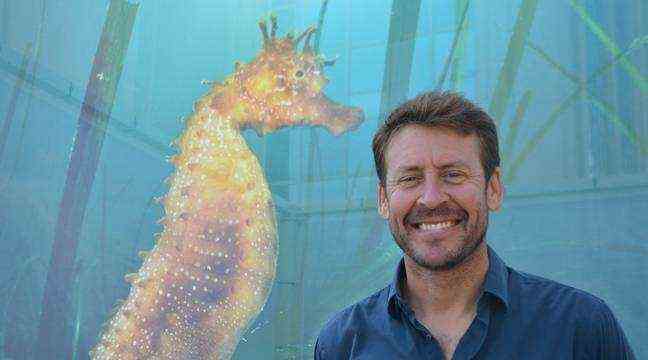Laurent Ballesta, in front of one of the photos of the Planète Méditerranée exhibition – N. Bonzom / Maxele Presse
- Photographer and marine biologist Laurent Ballesta unveils the photos he took during his expedition, in July 2019, to the Mediterranean, in an exhibition.
- The Montpelliérain was confined in July 2019, for 28 days, with three other divers, in a pressurized module of 5m2, between Marseille and Monaco.
- “It is a sea which is still alive and which conceals fascinating oases… This is what I wanted to show”, confides the one we saw in “Ushuaïa Nature”.
Astonishing creatures have taken over the square of the Hôtel de Région, in Montpellier (Hérault), and its hall, in Toulouse (Haute-Garonne). Until September 12, the photographer and marine biologist Laurent Ballesta reveals, through giant photographs, the astonishing encounters he made during his last expedition in the Mediterranean.
In July 2019, this Montpellier, real Cousteau of modern times, that we saw in Ushuaia Nature with Nicolas Hulot, confined himself, for twenty-eight days, with three other divers, in a pressurized module of 5 m2. It is from his outings, between Marseille (Bouches-du-Rhône) and Monaco, between 60 and 140 meters deep, that he brought back splendid photos. Sometimes unheard of for science.
“Every day, I was entitled to this little gift of nature”
“It’s twenty-eight days, locked in the bathyale station, breathing pure helium, undergoing thermal shocks, being too hot, or too cold, constantly, recalls the adventurer. But I felt rewarded. I made 21 new encounters. A living being, a creature, a shrimp, a fish that has never been observed alive, or a behavior of a known species, but whose reproduction or predation has never been seen. Every day, I was entitled to this little gift of nature. “
In this (free) exhibition, baptized Mediterranean planet, we thus come across a disturbing fish-beef, off the Promenade des Anglais, in Nice, splendid veined squid, in the Calanques or a strange moonfish, near Cap Taillat, in Ramatuelle. An expedition imagined, too, to put the spotlight on the jewels of Mediterranean flora and fauna. “We all know that the Mediterranean is doing badly, that it is polluted, overfished,” continues Laurent Ballesta. She suffers all the evils one can imagine. But that doesn’t mean she’s dead. It is a sea which is still alive and which conceals fascinating oases… This is what I wanted to show. “

